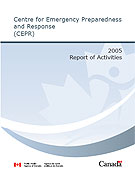Common menu bar links
Institutional links
Diseases & Conditions
Health & Safety
Research & Statistics
Agency Information
Search Box
E-mail this page
Centre for Emergency Preparedness and Response (CEPR)
2005
Report of Activities
Mission :
To promote and protect the
health of Canadians through leadership, partnership, innovation and
action in public health.
Table of Contents
- Executive Summary
- Director General’s Message
- Marking five years of growth and progress
- Section I - Where We’ve Come From
- The Creation of CEPR -2000
- CEPR Consolidation
- Section II - What we do
- Office of the Director General
- Office of Management and Administrative Services
- Office of Emergency Preparedness
- Office of Emergency Response Services
- Office of Laboratory Security
- Office of Public Health Security
- Section III - The Agency’s CEPR in 2005 — the Year at a Glance
Executive Summary
2005 was a year of internal renewal and external leadership for the Public Health Agency of Canada’s Centre for Emergency Preparedness and Response, as it reorganized key activity areas in laboratory security, public health security and emergency response, while expanding its national Emergency Preparedness and Response partnership and networking base with a view to developing a more integrated national health emergency management system across Canada.
Providing national leadership
The Public Health Agency of Canada continued its national leadership role in EPR coordination in 2005 by teaming up with the Public Safety and Emergency Preparedness Canada to co-host the 5th National Forum on Emergency Preparedness and Response, which brought EPR partners together to discuss ways of building a more integrated national health emergency management system.
The National Forum efforts were complimented by three additional national coordination initiatives in 2005: the development of a strategic action plan by the Public Health Agency of Canada’s CEPR regional coordinators to promote greater intergovernmental collaboration in emergency preparedness and response; a national consultation workshop on the development of a National Health Incident Management System (NHIMS); and ongoing dialogue on the development of a federal/provincial/territorial Memorandum of Understanding on Mutual Aid in an Emergency Affecting the Health of the Public.
Preparedness and response exercises
The Centre played a key role in improving Canada’s preparedness and response capacities in the face of public health security threats through its participation in two key exercises: the National Forum Exercise Coherence Trecedim, which addressed emergency planning and response management issues that could arise during the course of an influenza pandemic; and the TOPOFF 3 — TRIPLE PLAY counterterrorism exercise, which enabled Canada to assess its ability to act quickly, in concert with international partners, in the event of a terrorist attack or other major emergency.
Modernizing emergency stockpiles and building surge capacity
The forward-looking strategic review of the Agency’s National Emergency Stockpile System (NESS) continued in 2005 with the development of a strategic risk and threat analysis document by the Agency’s National Emergency Stockpile System (NESS) working group. The document is being used as a framework to design and plan a modern-day stockpile based on threat and casualty scenarios for natural and human-caused disasters and as a guide for the NESS procurement strategy. NESS also responded to the requests of expert groups such as the federal/provincial/territorial Pandemic Influenza Committee (PIC) to begin building a 20 percent federal surge capacity above and beyond current provincial and territorial stockpile levels to help respond to pandemic-type emergencies in Canada.
Revamping the national quarantine program
The passage of the new Quarantine Act in May 2005 ushered in a series of initiatives to revamp the CEPR’s national quarantine program, including: consultations with key federal, provincial, local and industry partners across the country prior to bringing the Quarantine Act into force; developing standard operating procedures to support the new Quarantine Act; and integrating quarantine services into Avian Influenza and pandemic planning initiatives to ensure a robust capacity for dealing with emerging infectious diseases.
Leadership in biosafety and biosecurity
The Public Health Agency of Canada’s CEPR Office of Laboratory Security (OLS) built on its reputation for leadership and innovation in 2005 by restructuring its core biosafety activities to respond to increasing stakeholder needs and expectations. The result of the restructuring is an OLS that is more flexible, more focussed and more responsive than ever to national and international stakeholder requirements.
As a World Health Organization (WHO) Collaborating Centre in Biosafety, the Agency’s OLS continued to play a leadership role in global public health security in 2005 by providing biosafety and biocontainment information and advice to national health authorities around the world through the WHO. The Agency’s OLS also participated in important international pubic health security initiatives such as the Global Health Security Action Group (GHSAG), serving as the lead on biosafety and Environmental Sampling within GHSAG’s Laboratory Network sub-group and chairing a special GHSAG working group on Environmental Sampling.
Enhancing health security response
Reorganization was a priority for the Agency’s Office of Public Health Security (OPHS) in 2005 as it repositioned key resources to provide a stronger, more centralized public health security response capacity for the Agency’s CEPR. As part of this repositioning, the OPHS assumed responsibility for the Agency’s CEPR’s state-of-the-art Emergency Operations Centre, taking significant steps to integrate EOC activities with longstanding OPHS responsibility areas such as Counter-Terrorism Coordination, Global Public Health Intelligence and Travel Medicine. By doing so, the Agency’s OPHS became the central locomotive for crisis response — both nationally and internationally — in 2005.
Continued leadership and growth
The combination of internal renewal and external leadership in 2005 has placed the Agency on a solid footing to advance EPR network building initiatives in 2006. Foremost among these initiatives will be continued efforts to expand the Centre’s EPR partnership base to a growing number of national voluntary organizations and professional health organizations across Canada. By continually expanding and strengthening these partnerships, the Agency will be better placed than ever to respond to public health aspects of natural and human-caused emergency events in Canada.

